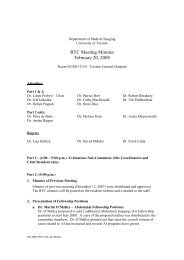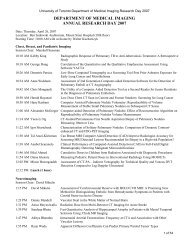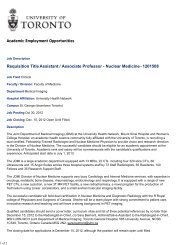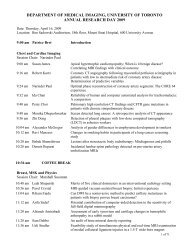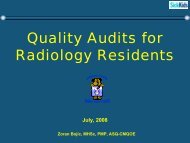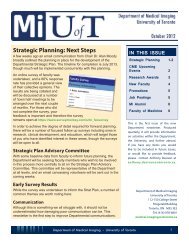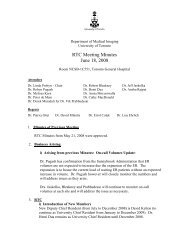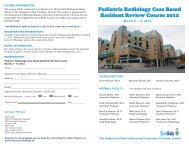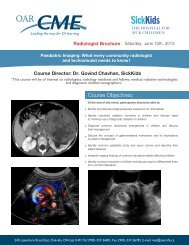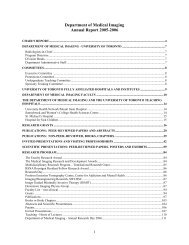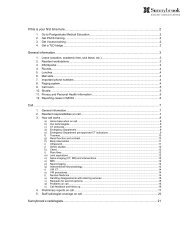Differentiation of Simple and Strangulated Small-Bowel Obstructions ...
Differentiation of Simple and Strangulated Small-Bowel Obstructions ...
Differentiation of Simple and Strangulated Small-Bowel Obstructions ...
Create successful ePaper yourself
Turn your PDF publications into a flip-book with our unique Google optimized e-Paper software.
greatly aids the diagnosis <strong>of</strong> smallbowel<br />
strangulation (15). The high<br />
attenuation <strong>of</strong> ascites on CT images<br />
<strong>of</strong> strangulated obstruction is probably<br />
caused by increased protein content<br />
in the fluid. However, in our study,<br />
the attenuation <strong>of</strong> ascites was cornpared<br />
with that <strong>of</strong> bile in the gallbladder<br />
or cysts in the liver or kidney, <strong>and</strong><br />
images <strong>of</strong> both simple <strong>and</strong> strangulated<br />
obstructions revealed hyperattentuating<br />
asdtes. Since a large amount<br />
<strong>of</strong> ascites may be caused by many<br />
conditions, confirmation <strong>of</strong> other CT<br />
findings in the mesentery or bowel is<br />
required so that the diagnosis <strong>of</strong> strangulation<br />
is not made incorrectly.<br />
We defined the mesenteric changes<br />
(haziness or vascular engorgement) as<br />
focal or diffuse because these changes<br />
may be observed on CT images <strong>of</strong> patients<br />
with simple small-bowel obstruction.<br />
As expected, focal mesenteric<br />
changes were seen on CT images<br />
<strong>of</strong> both simple <strong>and</strong> strangulated obstructions<br />
(Fig 9). Diffuse mesenteric<br />
changes, however, had high specificities<br />
(>95%) for the detection <strong>of</strong> strangulation.<br />
An unusual course <strong>of</strong> mesenteric<br />
vasculature (indicated with a<br />
reversed position <strong>of</strong> superior mesenteric<br />
artery <strong>and</strong> vein, the whirl sign,<br />
or convergence <strong>of</strong> vessels) has been<br />
seen also in cases <strong>of</strong> closed-loop obstruction<br />
(1,2,8) or malrotation (21).<br />
Although further study is necessary,<br />
some <strong>of</strong> these findings may be seen<br />
on CT scans <strong>of</strong> asymptomatic patients.<br />
Furthermore, strangulation does not<br />
always occur in patients with closedloop<br />
obstruction. Therefore, this finding-an<br />
unusual course <strong>of</strong> the mesenteric<br />
vasculature-alone on CT scans<br />
<strong>of</strong> patients with small-bowel obstruction<br />
does not always indicate bowel<br />
strangulation.<br />
Some drawbacks <strong>of</strong> our study could<br />
have reduced the reliability <strong>of</strong> the results.<br />
There were some differences in<br />
the scanning <strong>and</strong> contrast-infusion<br />
techniques at the two institutions where<br />
patients were evaluated; these might<br />
have affected the true frequency <strong>of</strong> CT<br />
findings that were analyzed. In addition,<br />
because strangulation can develop<br />
in only a few hours, the relatively long<br />
time (mean, 2 days) between CT examination<br />
<strong>and</strong> the surgery for obstruction<br />
in this study might have affected<br />
the severity <strong>of</strong> the obstructions exammed.<br />
Nevertheless, our study demonstrated<br />
the lack <strong>of</strong> sensitivity <strong>of</strong> known<br />
CT criteria when used alone <strong>and</strong> their<br />
relative diagnostic values. Furthermore,<br />
the use <strong>of</strong> a combination <strong>of</strong><br />
highly specific CT findings enabled<br />
differentiation <strong>of</strong> simple <strong>and</strong> strangulated<br />
obstruction in 85% <strong>of</strong> the patients<br />
in this retrospective study. Prospective<br />
application, however, <strong>of</strong> these<br />
CT criteria may not yield results as<br />
accurate as ours, as implied by Frager<br />
etal(6).<br />
In conclusion, the usefulness <strong>of</strong><br />
known CT criteria for aiding the diagnosis<br />
<strong>of</strong> strangulated small-bowel obstruction<br />
was examined with review<br />
<strong>of</strong> CT scans <strong>of</strong> a large number <strong>of</strong> patients<br />
with simple <strong>and</strong> strangulated<br />
small-bowel obstructions. Statistical<br />
analyses <strong>of</strong> various CT findings revealed<br />
that poor or no contrast enhancement<br />
<strong>of</strong> bowel wall, a serrated<br />
beak, a large amount <strong>of</strong> ascites, an unusual<br />
course <strong>of</strong> mesenteric vasculature,<br />
diffuse engorgement <strong>of</strong> mesenteric<br />
vasculature, <strong>and</strong> mesenteric<br />
haziness were the most useful CT<br />
findings for identifying strangulated<br />
obstruction. Detection <strong>of</strong> a combination<br />
<strong>of</strong> these CT findings increases the<br />
diagnostic accuracy <strong>of</strong> CT to enable<br />
differentiation <strong>of</strong> simple <strong>and</strong> strangulated<br />
small-bowel obstructions. #{149}<br />
Acknowledgment The authors thank Bonnie<br />
Hami, MA, for editorial assistance in preparation<br />
<strong>of</strong> the manuscript.<br />
References<br />
1. Balthazar EJ, Birnbaum BA, Megibow AJ,<br />
Gordon RB, Whelan CA, Hulnick DH.<br />
Closed-loop <strong>and</strong> strangulating intestinal<br />
obstruction: CT signs. Radiology 1992; 185:<br />
769-775.<br />
2. Balthazar EJ. CT <strong>of</strong> small-bowel obstruction.<br />
AJR 1994; 162:255-261.<br />
3. Megibow AJ, Balthazar EJ, Cho KC, Medwid<br />
SW, Birnbaum BA, Noz ME. <strong>Bowel</strong><br />
obstruction: evaluation with CT. Radiology<br />
1991; 180:313-318.<br />
4. Ha FIX, Park CH, Kim 5K, et al. CT analysis<br />
<strong>of</strong> intestinal obstruction due to adhesions:<br />
early detection <strong>of</strong> strangulation. J<br />
Comput Assist Tomogr 1993; 17:386-389.<br />
5. Ha HK. CT in the early detection <strong>of</strong> strangulation<br />
in intestinal obstruction. Semin<br />
Ultrasound CT MR 1995; 16:141-150.<br />
6. Frager D, Baer JW Medwid SW, Rothpearl<br />
A, Bossart P. Detection <strong>of</strong> intestinal ischemia<br />
in patients with acute small-bowel<br />
obstruction due to adhesions or hernia:<br />
efficacy <strong>of</strong> CT. AJR 1996; 166:67-71.<br />
7. Frager DH, Baer JW. Role <strong>of</strong> CT in evaluating<br />
patients with small-bowel obstruction.<br />
Semin Ultrasound CT MR 1995; 16:<br />
127-140.<br />
8. FisherJK. Computed tomographic diagnosis<br />
<strong>of</strong> volvulus in intestinal mairotation.<br />
Radiology 1981; 140:145-146.<br />
9. WillsJS. Closed-loop <strong>and</strong> strangulating<br />
obstruction <strong>of</strong> the small intestine: a new<br />
twist. Radiology 1992; 185:635-636.<br />
10. Fukuya T, Hawes DR. Lu CC, Chang PJ,<br />
Barloon TJ. CT diagnosis <strong>of</strong> small-bowel<br />
obstruction: efficacy in 60 patients. AJR<br />
1992; 158:765-769.<br />
11. Gazelle CS, Goldberg MA, WiftenbergJ,<br />
Halpern EF, Pinkney L, Mueller PR Efficacy<br />
<strong>of</strong> CT in distinguishing small-bowel<br />
obstruction from other causes <strong>of</strong> smallbowel<br />
dilatation. AJR 1994; 162:43-47.<br />
12. Coblentz CL, Babcook CJ, Alton D, Riley BJ,<br />
Norman C. Observer variation in detecting<br />
the radiologic features associated with<br />
bronchiolitis. Invest Radiol 1991; 26:115-<br />
118.<br />
13. Hosmer DWJr, Lemeshow S. Applied<br />
logistic regression. New York, NY: Wiley,<br />
1989; 1-23.<br />
14. Laufman H, Nora PF. Physiological problems<br />
underlying intestinal strangulation<br />
obstruction. Surg Clin North Am 1966; 42:<br />
219-229.<br />
15. Leffall LDJr, Qu<strong>and</strong>erJ, Syphax B. Strangulation<br />
intestinal obstruction: a clinical<br />
appraisal. Arch Surg 1965; 91:592-596.<br />
16. Alpem MB, Glazer CM, FranCis IR. Ischemic<br />
or infarcted bowel: CT findings. Radiology<br />
1988; 166:149-152.<br />
17. Federle M1 Chun C,Jeffrey RB, Rayor R<br />
Computed tomographic findings in bowel<br />
infarction. AJR 1984; 142:91-95.<br />
18. Teefey SA, Roarke MC, BrinkJA, et al.<br />
<strong>Bowel</strong> wall thickening: differentiation <strong>of</strong><br />
inflammation from ischemia with color<br />
Doppler <strong>and</strong> duplex US. Radiology 1996;<br />
198:547-551.<br />
19. Zalcman M, Cansbeke V, Lalm<strong>and</strong> B,<br />
Braude P, atj, StruyvenJ. Delayed<br />
enhancement <strong>of</strong> the bowel wall: a new CT<br />
sign <strong>of</strong> small-bowel strangulation. J Comput<br />
Assist Tomogr 1996; 20:379-381.<br />
20. SaItZSteIn EC, Marshall WJ, Freeark RJ.<br />
Gangrenous intestinal obstruction Surg<br />
CynecolObstet 1962; 114:694-699.<br />
21. Gaines PA, Saunders AJS, Drake D. Midgut<br />
malrotation diagnosed by ultrasound.<br />
Clin Radiol 1987; 38:51-53.<br />
512 #{149} Radiology August 1997




